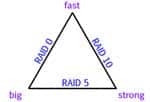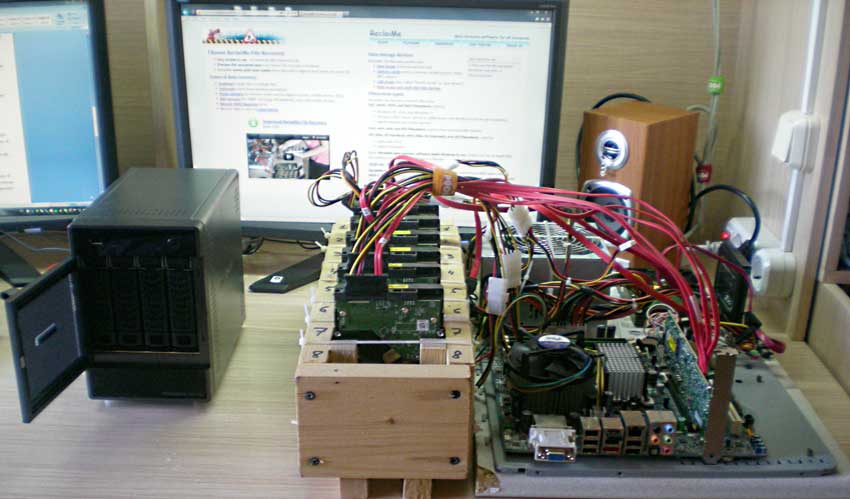 Before you start to build or purchase your own RAID you need to decide on three of the following factors. how big – how much capacity you need, how strong – what fault tolerance is needed, and how fast – what performance in terms of write/read speed you want. In this guest editorial we cover the planning stages of building or purchasing a RAID solution.
Before you start to build or purchase your own RAID you need to decide on three of the following factors. how big – how much capacity you need, how strong – what fault tolerance is needed, and how fast – what performance in terms of write/read speed you want. In this guest editorial we cover the planning stages of building or purchasing a RAID solution.
By: Elena Pakhomova, Marketing and Development for data recovery software company ReclaiMe.com
Before you start to build or purchase your own RAID you need to decide on the following:
- How big – how much capacity you need
- How strong – what fault tolerance is needed
- How fast – what performance in terms of write/read speed you want
Additionally, you should choose the way your RAID device will be connected – via a network or to a PC directly. A storage connected via a network is called Network Attached Storage or NAS for short (Netgear, QNAP); a device connected via USB, eSATA, or FireWire is called Direct Attached Storage or DAS for short (LaCie, Drobo). Any type of these can implement a RAID in it; however, DIY units are mostly limited to NAS. Direct Attached Storage may be faster, especially if connected via eSATA, but it can only be connected to one PC at a time like an external hard drive. NAS can serve multiple PCs simultaneously, like a file server.
When making a decision about the desired performance for your RAID (both NAS and DAS), you should consider what maximum speed the disks provide, RAID level, and also the maximum throughput of the connection.
RAID 0
Despite the fact that this RAID layout is often used, but there are very few cases where its usage is justified. Almost the only feasible use of RAID0 is to store temporary files involved in graphics processing, video editing, or scientific computations. Even for these purposes, one large RAID0 array consisting of many disks usually works worse than several separate disks. You can get better performance by placing the files so that each separate drive serves one I/O stream. This way, seeks are greatly reduced.
Fault Tolerant Arrays
In all other cases it is recommended to use a fault tolerant RAID layout. Usually the choice is between RAID5, RAID6, and RAID10. Another fault tolerant array RAID1 is used when you need a redundant storage of less than one disk capacity, like in case of system partitions. The decision is made based on the following considerations:
- If random writes are required, choose RAID10.
- If you are not concerned with random writes, then with fewer disks, choose RAID5, with more disks, choose RAID6. The tipping point is around five – six disks.
Backup
Decide where, when, and how often you will backup data stored on RAID. Even if you deal with a fault tolerant array, you still need a backup. The proof of this is too large to fit in the margin.
Hot spare
If you deal with a RAID consisting of five and more disks, add a hot spare disk. It allows the device to replace a dropped disk immediately without human interaction.
Write back caching and uninterruptable power supply
Write cache improves RAID5 and especially RAID6 performance significantly. However, if power is lost during the write, data may be damaged in many different ways starting with database and filesystem corruption and ending with a RAID write hole. RAID controllers with Battery Backup Unit (BBU) or UPS providing correct shutdown of the system reduce these problems.
Generally speaking, UPS is better because it allows you to shut down the system properly. BBU only keeps the cache data for a day or so (12 to 72 hours) and if the power would not be restored by this time, data in cache is lost.
DIY or Ready-Made Device?
Generally, feasibility of using DIY devices is determined by whether there are skilled people who could build it and then repair it when the need arises. Both DIY servers and ready-made storages require approximately the same maintenance – if the device is located in a dusty room, you should clean out the dust every six months or every year. The device does all the rest maintenance procedures on its own and if necessary sends messages about problems via email.

NETGEAR 4-bay ReadyNAS (left) vs. DIY 8-bay storage solution (right and center)
Failures
Sooner or later any system fails. Some day your storage device will fail as well. If possible you should determine in advance who will repair it. This affects the choice of operating system which will manage your RAID or even the choice between DIY and ready-made solution. If possible, choose a system which you, in case you will repair it, or the person you will ask for help in repairs, know well.
ReclaiMe is a simple to use file recovery software that lets users preview recovered data before recovery is complete and works on almost any media.
